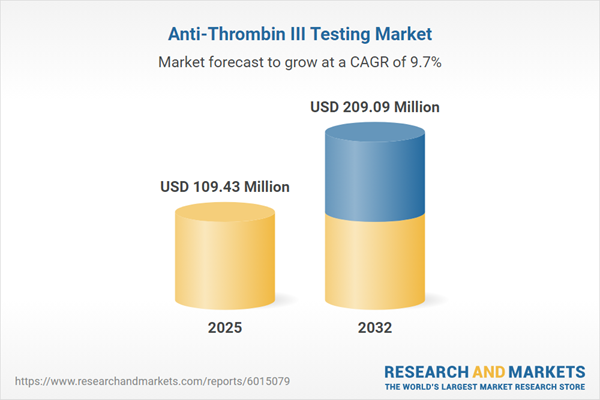Speak directly to the analyst to clarify any post sales queries you may have.
Senior decision-makers are prioritizing diagnostic solutions that increase laboratory reliability, streamline compliance, and position their organizations for sustained growth. The Anti-Thrombin III Testing Market is proving pivotal for leaders who seek to modernize workflows and boost operational resilience amid evolving healthcare and regulatory challenges.
Market Snapshot: Anti-Thrombin III Testing Market Trends and Growth
The Anti-Thrombin III Testing Market is on a steady upward trajectory, expanding from USD 99.84 million in 2024 to USD 109.43 million in 2025 and projected to reach USD 209.09 million by 2032. This growth, anchored by a compound annual growth rate of 9.68%, reflects the sector’s response to increased demand for precise coagulation testing, investment in laboratory automation, and a focus on long-term compliance. Healthcare organizations are adopting integrated diagnostic platforms to consolidate workflows, reinforce data integrity, and ensure connectivity across hospital, clinic, and independent laboratory settings, driving measurable improvements in patient diagnostics and care quality.Scope & Segmentation of the Anti-Thrombin III Testing Market
- Product Types: Automated analyzers, semi-automated analyzers, manual analyzers, specialized reagents, laboratory consumables, complete test kits, software integration platforms, maintenance programs, and technical training services form the backbone of operational support, providing flexibility for varying lab readiness and complexity.
- Assay Technologies: Chromogenic assay solutions, manual and automated clot-based detection, chemiluminescent immunoassays, and ELISA methods all contribute to reliable diagnostics, enabling accurate anti-thrombin III measurement and reducing result variability.
- End Users: Independent diagnostic laboratories, private medical clinics, multi-level hospitals, and research organizations in academic, clinical, and pharmaceutical domains shape market demand, each with unique regulatory and data management protocols.
- Applications: Areas of application include cardiovascular disease management, evaluation of venous thromboembolism, monitoring of disseminated intravascular coagulation, pharmaceutical biomarker identification, and supporting genetic research for new drug development.
- Regions Covered: The Americas, Europe, Middle East, Africa, and Asia-Pacific are central regions, with focused analysis on the United States, Germany, Japan, Brazil, and India helping align strategies with local compliance and market needs.
- Company Profiles: Major industry participants such as F. Hoffmann-La Roche Ltd, Siemens Healthineers AG, Abbott Laboratories, Danaher Corporation, Instrumentation Laboratory Company, Sysmex Corporation, Thermo Fisher Scientific Inc., Helena Laboratories Corporation, Bio-Rad Laboratories, Inc., and Hyphen BioMed SAS shape sector innovation and reliability through robust technology solutions and global distribution capabilities.
Key Takeaways for Senior Decision-Makers
- Transitioning toward automated and semi-automated systems enhances lab consistency, supports efficiency gains, and helps reduce manual handling errors in high-volume diagnostic settings.
- Digital integration platforms offer advanced data management, enabling labs to monitor results and analytics in real time, even during periods of operational disruption.
- Specialized anti-thrombin III testing solutions help clinical teams respond more swiftly to complex cardiovascular and coagulation cases, improving care delivery timelines.
- Keeping pace with shifting international standards supports reliable outcomes, minimizes workflow disturbances, and protects the organizational reputation within the diagnostic community.
- Strong collaboration between lab management, clinical stakeholders, and suppliers enables smooth roll-out of new technologies and rapid adaptation to ongoing advances.
- Procurement strategies differ regionally: mature markets refine digital infrastructure for competitive positioning, while underserved regions prioritize scalable, cost-effective diagnostics to meet growing healthcare demands.
Tariff Impact and Supply Chain Adaptation
Recent tariff policy changes in the United States have prompted suppliers and laboratories to adjust sourcing strategies for anti-thrombin III testing equipment and reagents. Expanding domestic manufacturing and deepening relationships with regional distributors are mitigating potential disruptions. Laboratories are increasing investments in compliance, remote maintenance strategies, and training their workforce virtually to reinforce supply chain stability and ensure continuous service.
Methodology & Data Sources
This market analysis draws from primary interviews with healthcare professionals, laboratory directors, technical experts, and hematologists. Comprehensive validation from scientific literature, regulatory documentation, sector benchmarks, and case studies ensures that each insight presented is actionable and verified.
Why This Report Matters in the Anti-Thrombin III Testing Market
- Supports healthcare executives in benchmarking diagnostic technology investments, procurement, and compliance methods against current industry standards.
- Offers strategic guidance for navigating fluctuating supply chains and regulatory changes, helping to secure workflow stability within laboratory environments.
- Delivers actionable insights that inform planning for laboratory automation, digital upgrades, and resilience measures in an evolving market landscape.
Conclusion
This report equips senior leaders with a pragmatic roadmap to advance laboratory operations, adapt to evolving regulatory expectations, and ensure continued performance in the Anti-Thrombin III Testing Market.
Additional Product Information:
- Purchase of this report includes 1 year online access with quarterly updates.
- This report can be updated on request. Please contact our Customer Experience team using the Ask a Question widget on our website.
Table of Contents
3. Executive Summary
4. Market Overview
7. Cumulative Impact of Artificial Intelligence 2025
Companies Mentioned
The companies profiled in this Anti-Thrombin III Testing market report include:- F. Hoffmann-La Roche Ltd
- Siemens Healthineers AG
- Abbott Laboratories
- Danaher Corporation
- Instrumentation Laboratory Company
- Sysmex Corporation
- Thermo Fisher Scientific Inc.
- Helena Laboratories Corporation
- Bio-Rad Laboratories, Inc.
- Hyphen BioMed SAS
Table Information
| Report Attribute | Details |
|---|---|
| No. of Pages | 184 |
| Published | November 2025 |
| Forecast Period | 2025 - 2032 |
| Estimated Market Value ( USD | $ 109.43 Million |
| Forecasted Market Value ( USD | $ 209.09 Million |
| Compound Annual Growth Rate | 9.6% |
| Regions Covered | Global |
| No. of Companies Mentioned | 11 |









